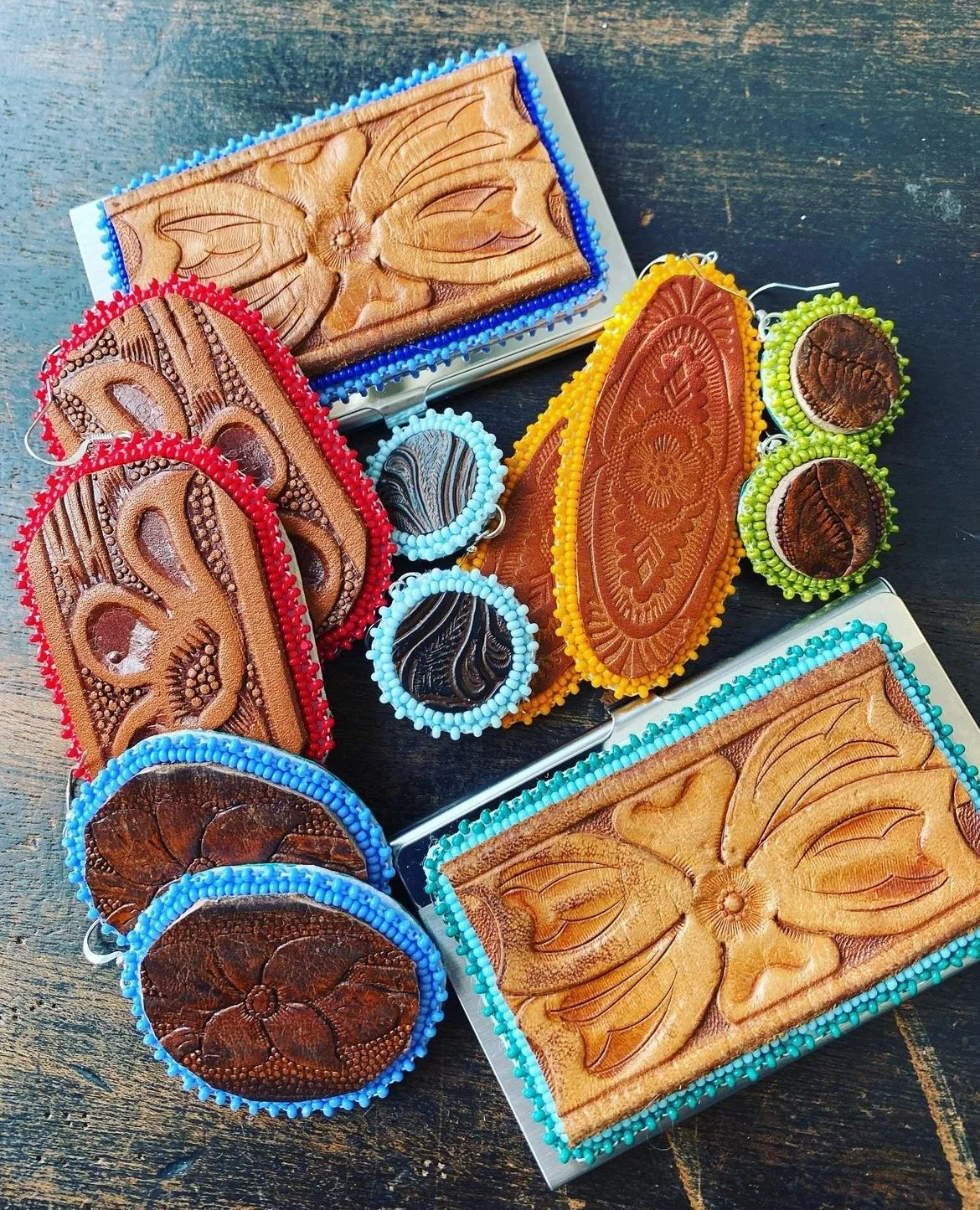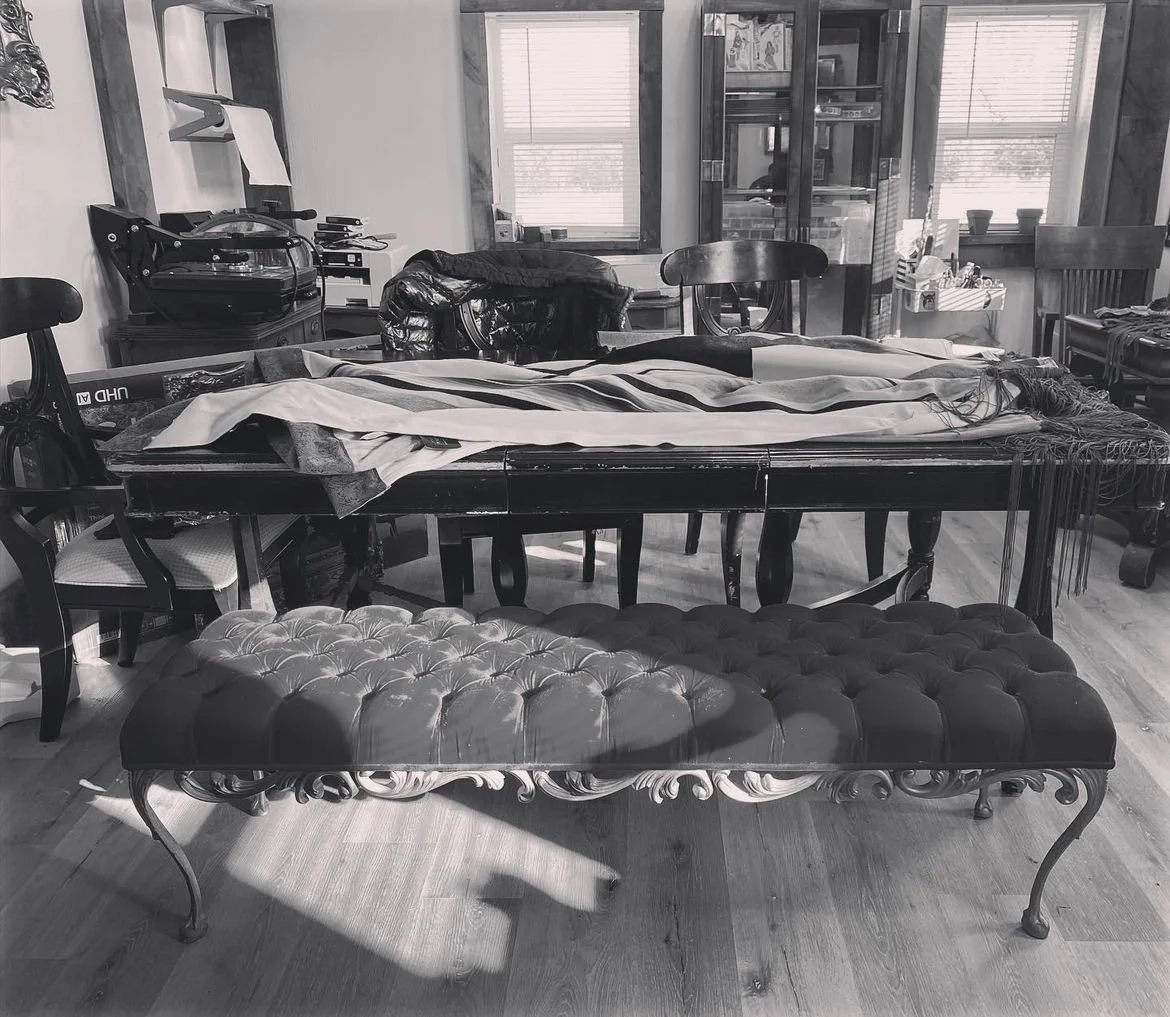Plains Soul
Plains Soul
We Are Still Here
Beaded judge’s robe by Moran McCleary. Courtesy of the artist.
Carrie Moran McCleary (she/her) can’t remember a time before she knew how to sew. “I don’t remember learning to sew. I just remember already sewing,” she says, reflecting on when she began making art. Today, Moran McCleary is a full-time, multimedia artist and fashion designer. She is also the founder and host of Plains Soul “Rock Your Beads Night,” which brought all of the artists in this exhibition into community with one another.
The brand Plains Soul grew out of Moran McCleary’s long-time love of creating. At age three she was already sewing and making clothes for her dolls. By the second grade, she remembers making hair ties using fur, leather, and beads. When she was in the fifth grade, her mom taught her to loom bead, and by college she had taught herself to flat bead. “I was just always really intent on multimedia creations. I would go out into the field at our house and get a branch and I’d cover it in moss, then I’d go find feathers and attach yarn and beads and make a little wall hanging.” She laughs, “I’m sure my whole family thought I was crazy. Well, I know they did.” In 2016, after years of designing clothes and accessories for her family, she founded Plains Soul to share her unique style and artistry with a wider audience.
Moran McCleary is a member of the Little Shell Chippewa Tribe of Montana and lives and works on Apsáalooke lands. Her work is influenced by both her Little Shell background, which you can see in her striking woodland florals, and her adoptive Apsáalooke home and family, which is where she makes and sells the majority of her work. The throughline in all of her work is the message “we are still here,” a reminder to everyone that Native people are an integral part of our contemporary world and that Native artistic practices and cultures are dynamic and changing, not relics of the past.
Earrings and business card cases by Moran McCleary made from upcycled leather belts. Courtesy of the artist.
Growing up one of 11 kids, sewing and upcycling, now staples of Moran McCleary’s artistic practice, were just part of everyday life. “Growing up my mom upcycled a lot of our clothing. We had a rag bag underneath the laundry table. Before something went in the rag bag, we cut off the buttons, we cut off the zippers so they could be reused and nothing really got thrown out, it got turned into something else,” she says, “today, I think it’s something we need to consider… because fast-fashion is a real issue for climate change.” To create her vibrant, upcycled looks, Moran McCleary says she is “constantly thrifting stuff and saving it for later.” About 95% of her fabric comes from thrift stores
In addition to her upcycled looks, Moran McCleary has a ready-to-wear line. “My ready-to-wear line is a way for me to extend the life of my beadwork art,” she explains. “The majority of it is actually photographs of my beadwork pieces, which I then use as designs for fabrics.” At the same time, she is really mindful about the amount of waste and energy that having a ready-to-wear line can produce. “We have to have a happy medium,” she says, “So we’re upcycling purses, we’re upcycling clothing, we’re upcycling even beadwork.”
“I’m really interested in the connection between old and new, and ways of adding modern takes on old or traditional styles.”
Unique florals by Moran McCleary that show her colorful palette. Courtesy of the artist.
For Moran McCleary, upcycling isn’t just a way of being environmentally conscious, it also helps express the philosophy behind her designs: “I’m really interested in the connection between old and new, and ways of adding modern takes on old or traditional styles.” Fashioning a new beadwork design on vintage outfit or upcycled beadwork to a modern look allows Moran McCleary to develop a style that’s completely unique and her own. “I would say I’m very influenced by vintage looks in fashion,” she says, as well as beadwork from the 1850s to 1920s. “I have been fortunate to go through a lot of different museum collections and see techniques and colors and also upcycled items, which is a cool message for me because that’s what I do.” While she draws inspiration from works in museum collections, she’s always thinking of ways to create new and innovative work: “While I enjoy the actual design of the old florals, I tend to add a lot more color. I will work on something in maybe 7-20 colors instead of 5-6.”
Creating community around art is incredibly important for Moran McCleary. She has a crew of close friends and fellow artists on the Apsáalooke Reservation that she works with. They share ideas, travel to shows together, and accompany one another on thrifting adventures.
In 2018, she started Plains Soul “Rock Your Beads Night” to extend this community to artists who live in other areas and needed the time and space to get some beading done. She recalls the early days of “Rock Your Beads Night” before the pandemic: “We would do a group call on Messenger. We did that for about a year, a year in a half. We had a few people. There would be maybe four or five of us, and it was fun. That was how it started, then it kind of died out.” When COVID hit, Moran McCleary revived Bead Night, switching to Zoom to better accommodate new guests. The first meeting was March 16, 2020, just a few days after the first major shut down of the pandemic:
“The whole shut down was so new and so foreign that reaching out and meeting a bunch of strangers wasn’t as strange as it would have been one month before. Suddenly it was like we’re going to have to try new things, it’s a new world. I don’t think you would’ve had that many people start showing up without the pandemic. And the first one, we had 11 people, which I was shocked by because I was used to 4 or 5. And it was just so fun. As Native people, we’re very different, but at the same time we’re very similar. We have shared trauma, shared histories, no matter where we are in North America. And that bonds us together. Those experiences bond us together.”
Image of Bead Night from Moran McCleary’s work table. Courtesy of Moran McCleary.
Over time, Bead Night has evolved to be more than a group of strangers looking for connection during a time of isolation. “We’ve gotten to be more intimate in some ways,” Moran McCleary notes. “Over time we became very comfortable in the Zoom format. And we’re doing that on a weekly basis. How many friends do you see every single week for two to six hours? Also artwork is very therapeutic and very personal. So while you’re sitting there painting, you’re thinking about grandma and grandpa, you’re thinking about the people you’ve lost that you painted that for. You’re thinking about the people that taught you how to bead or taught you how to quill and that’s real intimate too.” Over the past three years, deep and supportive friendships have formed among the members of Bead Night.
Moran McCleary reflects, too, on the difficulties that sometimes arise when getting such a large and diverse group together: “We’ve tried to keep it a safe space. I’m not going to say we haven’t had issues, because we have. But I really try to check in with the group as the host and keep open communication. And, frankly, since the pandemic, there've been a lot of tumultuous things going on in Indian Country that affected everyone.” While it hasn’t always been easy, the members of the group try to always support one another as people and artists.
Moran McCleary has benefited from the expertise and advice of other artists on Bead Night: “Bead Night has influenced me to try new techniques and to try new and different tools. I’d never tried different tools before, but watching other artists in their practice and taking their recommendations for what works and what doesn’t work has been so helpful. For example, on buckskin, someone suggested a different kind of needle, and I now use that when I work on leather. It sounds small, but it’s life-changing.”
Bead Night posters from @PlainsSoul
Image from inside the Plains Soul studio. Courtesy of Moran McCleary.
Fellow Bead Night artist Crystal Lepscier captures what many artists from the beading circle have said about Moran McCleary: “Carrie is an amazing artist and advocate for the community. She shared her space, time, and positivity, which drew me into her circle.” This year, Moran McCleary is opening a Plains Soul studio and retail space where she can display the full breadth of her work and talent. As an artist and small-business owner, she is always dreaming big and then working hard to make those dreams come true - not just for herself, but for her community too.
Artist Biography
Carrie Moran McCleary is a Little Shell Chippewa Tribal member and the proud host of Plains Soul Rock Your Beads Night. She started Bead Night at the beginning of the pandemic and continued afterwards, unable to abandon the community created across geographical borders and Tribal nations. She is the owner an artist of Plains Soul a beading, fashion, and home goods company based on the Crow Reservation in south central Montana where she’s lived for the last thirty years. Her work is centered on traditional designs, a love of upcycling, and a need to juxtapose old and new, rustic and glamorous and creating work for everyday use.
Moran McCleary has participated in Montana Fashion Week, Native Fashion in the City, and Honor Our Legacy Fashion Show. She co-produced and participated in Apsáalooke Community Market’s Native Days, Yellowstone National Park’s Tribal Marketplace, and the Crow Fair 101 fashion shows. Her work has been exhibited in Apsáalooke Women and Warriors at the Field Museum, Chicago, IL and the Museum of the Rockies in Bozeman, MT, The Brinton 101 at The Brinton Museum in Big Horn, WY, and When Culture Meets Fashion at the Western Heritage Center in Billings MT.









